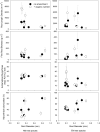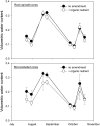Root morphology and mycorrhizal symbioses together shape nutrient foraging strategies of temperate trees
- PMID: 27432986
- PMCID: PMC4978252
- DOI: 10.1073/pnas.1601006113
Root morphology and mycorrhizal symbioses together shape nutrient foraging strategies of temperate trees
Abstract
Photosynthesis by leaves and acquisition of water and minerals by roots are required for plant growth, which is a key component of many ecosystem functions. Although the role of leaf functional traits in photosynthesis is generally well understood, the relationship of root functional traits to nutrient uptake is not. In particular, predictions of nutrient acquisition strategies from specific root traits are often vague. Roots of nearly all plants cooperate with mycorrhizal fungi in nutrient acquisition. Most tree species form symbioses with either arbuscular mycorrhizal (AM) or ectomycorrhizal (EM) fungi. Nutrients are distributed heterogeneously in the soil, and nutrient-rich "hotspots" can be a key source for plants. Thus, predicting the foraging strategies that enable mycorrhizal root systems to exploit these hotspots can be critical to the understanding of plant nutrition and ecosystem carbon and nutrient cycling. Here, we show that in 13 sympatric temperate tree species, when nutrient availability is patchy, thinner root species alter their foraging to exploit patches, whereas thicker root species do not. Moreover, there appear to be two distinct pathways by which thinner root tree species enhance foraging in nutrient-rich patches: AM trees produce more roots, whereas EM trees produce more mycorrhizal fungal hyphae. Our results indicate that strategies of nutrient foraging are complementary among tree species with contrasting mycorrhiza types and root morphologies, and that predictable relationships between below-ground traits and nutrient acquisition emerge only when both roots and mycorrhizal fungi are considered together.
Keywords: mycorrhizal fungi; plant traits; root proliferation; soil heterogeneity; symbioses.
Conflict of interest statement
The authors declare no conflict of interest.
Figures









Similar articles
-
Complementarity in nutrient foraging strategies of absorptive fine roots and arbuscular mycorrhizal fungi across 14 coexisting subtropical tree species.New Phytol. 2015 Oct;208(1):125-36. doi: 10.1111/nph.13434. Epub 2015 Apr 27. New Phytol. 2015. PMID: 25925733
-
Complementary foraging of roots and mycorrhizal fungi among nutrient patch types in four subtropical monospecific broadleaved tree plantations.New Phytol. 2025 Aug;247(3):1401-1414. doi: 10.1111/nph.70263. Epub 2025 Jun 3. New Phytol. 2025. PMID: 40458963
-
Linking root traits to nutrient foraging in arbuscular mycorrhizal trees in a temperate forest.New Phytol. 2015 Oct;208(1):114-24. doi: 10.1111/nph.13451. Epub 2015 May 13. New Phytol. 2015. PMID: 25970701
-
Mycorrhizal types differ in ecophysiology and alter plant nutrition and soil processes.Biol Rev Camb Philos Soc. 2019 Oct;94(5):1857-1880. doi: 10.1111/brv.12538. Epub 2019 Jul 3. Biol Rev Camb Philos Soc. 2019. PMID: 31270944 Review.
-
Split down the middle: studying arbuscular mycorrhizal and ectomycorrhizal symbioses using split-root assays.J Exp Bot. 2022 Mar 2;73(5):1288-1300. doi: 10.1093/jxb/erab489. J Exp Bot. 2022. PMID: 34791191 Review.
Cited by
-
Nutrient trade-offs mediated by ectomycorrhizal strategies in plants: Evidence from an Abies species in subalpine forests.Ecol Evol. 2021 Mar 16;11(10):5281-5294. doi: 10.1002/ece3.7417. eCollection 2021 May. Ecol Evol. 2021. PMID: 34026006 Free PMC article.
-
Nonlinearity of root trait relationships and the root economics spectrum.Nat Commun. 2019 May 17;10(1):2203. doi: 10.1038/s41467-019-10245-6. Nat Commun. 2019. PMID: 31101818 Free PMC article.
-
Influence of Heterogeneous Karst Microhabitats on the Root Foraging Ability of Chinese Windmill Palm (Trachycarpus fortunei) Seedlings.Int J Environ Res Public Health. 2020 Jan 9;17(2):434. doi: 10.3390/ijerph17020434. Int J Environ Res Public Health. 2020. PMID: 31936453 Free PMC article.
-
Phytate and Microbial Suspension Amendments Increased Soybean Growth and Shifted Microbial Community Structure.Microorganisms. 2021 Aug 25;9(9):1803. doi: 10.3390/microorganisms9091803. Microorganisms. 2021. PMID: 34576699 Free PMC article.
-
Arbuscular Mycorrhizal Fungi Increase Pb Uptake of Colonized and Non-Colonized Medicago truncatula Root and Deliver Extra Pb to Colonized Root Segment.Microorganisms. 2021 Jun 2;9(6):1203. doi: 10.3390/microorganisms9061203. Microorganisms. 2021. PMID: 34199397 Free PMC article.
References
-
- Wright IJ, et al. The worldwide leaf economics spectrum. Nature. 2004;428(6985):821–827. - PubMed
-
- Chave J, et al. Towards a worldwide wood economics spectrum. Ecol Lett. 2009;12(4):351–366. - PubMed
-
- Drew MC, Saker LR. Nutrient supply and the growth of the seminal root system in barley. II. Localized, compensatory increases in lateral root growth and rates of nitrate uptake when nitrate supply is restricted to only part of the root system. J Exp Bot. 1975;26(1):79–90.
-
- Grime JP. Plant Strategies, Vegetation Processes, and Ecosystem Properties. Wiley; Chichester, UK: 2001.
Publication types
MeSH terms
Substances
LinkOut - more resources
Full Text Sources
Other Literature Sources

